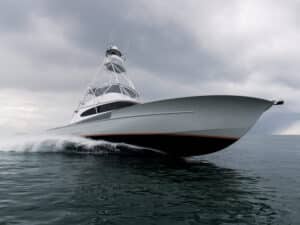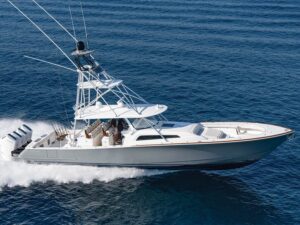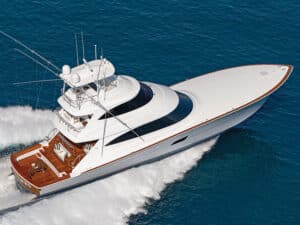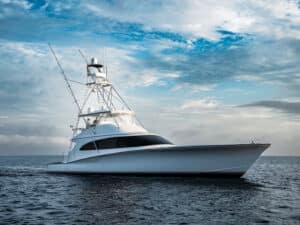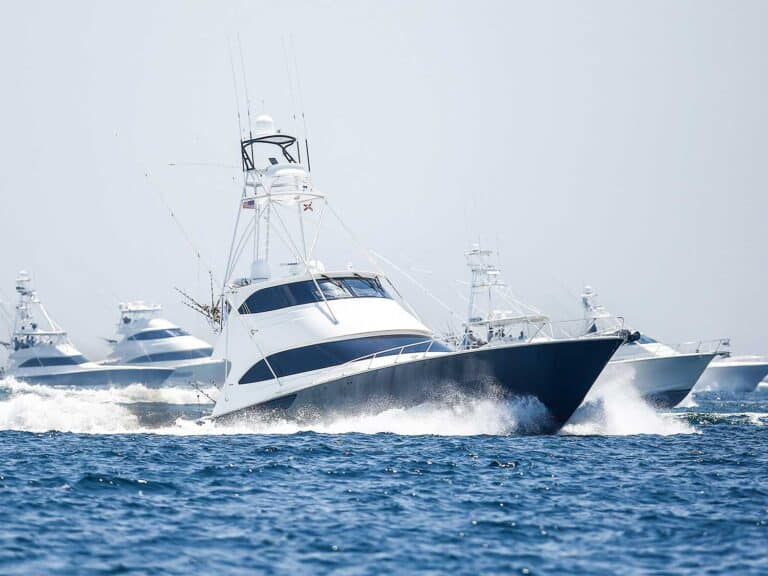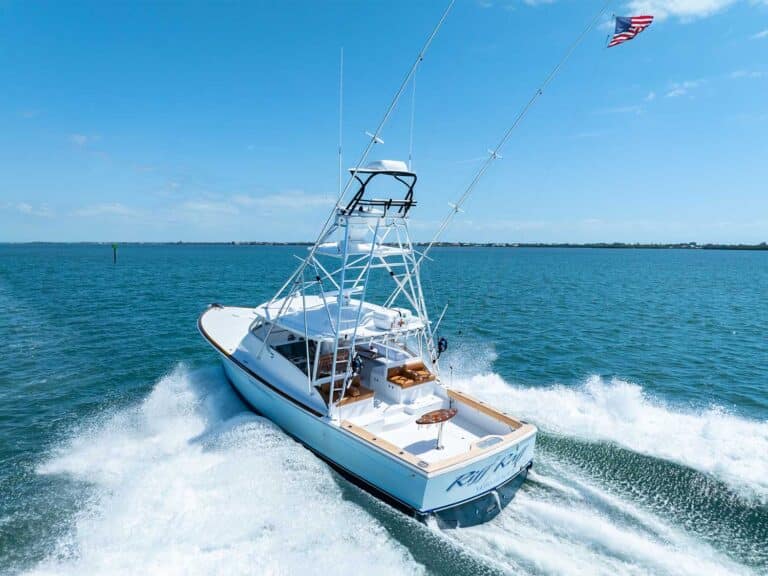Hatteras exited the economic morass of recent years with a roar rather than a whimper, introducing three all-new models in what it calls its GT series: a 54, a 60 and a 63. We ran (and reported on) the GT60 in our November 2010 issue. Several weeks ago, I got the chance to sea trial the new GT54 on a horrendous day in Fort Lauderdale, Florida.
Performance
Interestingly, when spinning on a fish, the GT54 turns virtually as quickly without as it does with rudder. Backing down proved most impressive, with a speed of 9½ knots in reverse before a drop of water came over the transom. When it did, the innovative scupper design emptied the cockpit quickly. These scuppers drain straight through the outer hull, but they are hidden in profile as the water exits out the aft end of the splash/rub rail. Ingenious!
When turning, a mechanical differential-steering system turns the inboard rudder more than the outboard rudder, thereby creating a tighter turn. Overall, turn response qualifies as completely predictable, and that’s high praise.
During what we hoped was the last cold front of the year, winds blew in from the north at 20 knots, generating 3- to 4-foot seas nearshore and quickly building to 8 to 10 feet just a short way out. I didn’t envy anyone trying to cross the Gulf Stream with that stiff north wind opposing the strong southerly current.
Drifting in the big troughs was majestic rather than uncomfortable thanks to a very short roll moment and gentle transitions. As far as pure performance goes, make no mistake: This is a very quick boat. Running in the troughs, I managed a top speed of 41.3 knots, and I sensed that the boat had a tad more to offer. But at the other end of the spectrum, you need to really pay attention when running at harbor speeds – you can throw an impressive wake unless you take one engine out of gear. Hatteras installs bow thruster tubes in each hull whether you opt for a thruster or not. This particular hull did not, and at 54 feet, I didn’t really miss it.
Cockpit
The cockpit space easily accommodates two anglers plus three mates with nary a conflict, even with the Pompanette fighting chair in place. Hatteras provides plenty of storage under the gunwales and under the seats on the mezzanine. In fact, I counted 22 standard-issue rod holders around the cockpit.
You’ll find plenty of cooler and freezer space in the mezzanine, along with an Eskimo ice maker dump and other refrigerated spaces. What I especially like is that Hatteras glasses the chill coils into the resin-infused boxes, so you never need to worry about plates or damaging coils.
Certainly, you can set your cockpit up any way you choose, but this particular hull sported an underdeck livewell to port, a fish box to starboard and the lazarette under the fighting chair’s footrest. The fish boxes seemed to be a tad shallow due to their location atop the prop tunnels.
Though not in the cockpit, I did notice two other on-deck items. One is the excellent anchor locker with wash down. Hatteras provides a generous hawsehole, so you don’t need to leave your anchor hatch open when you’re on the hook. The other is the set of steps and handholds on the transom that allow someone in the water to re-board. On the slightly negative side (though easily fixable), the forward corners of the cabin house need a black handle that blends in with the brow mask as you walk to the foredeck. Without it, you’re left with an insecure no man’s land between the side deck and the open foredeck.
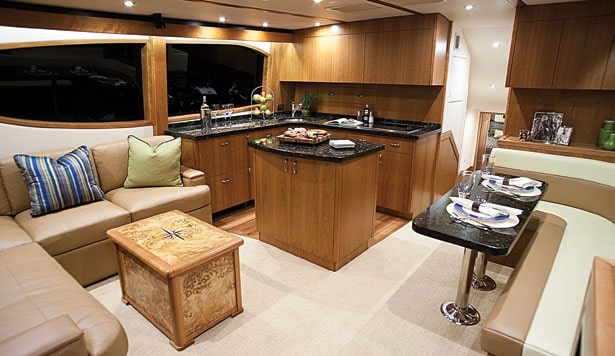
Interior
The overall flavor of the interior is very simple, but elegant luxury, thanks especially to the flawless woodwork. Huge windows afford a view of the outdoors whether seated or standing, and they’re so big that they provide exceptional ambient lighting in the salon. The interior is strikingly different from traditional styling, even sporting a small island in the galley. I like the room to move, but would love to see the many sharp granite corners rounded off. Fall against one in a sea and it will surely leave a mark.
Galley appliances fit the norm with refrigerator/freezer drawers, microwave/convection oven, ceramic cooktop and slide-out drawers behind cabinet doors. The dinette legitimately seats four adults, and while the salon’s L-shaped settee offers a storage box/coffee table nearby, you could easily design and build a table with foldaway extensions to seat still more guests for dinner if you so wished.
Belowdecks, the master cabin to port boasts a queen berth with storage beneath and a private en-suite head with shower. Across the corridor, you’ll find the crew’s quarters several steps down to some fairly tight single berths. An option exists for adding a third single pullman berth. The forward cabin sports a very nice island double, again with storage beneath and plenty of ancillary storage as well. The crew and the guest cabin share a “day head.”
Engine Room
You enter the engine compartment via the centerline hatch in the mezzanine. Once inside, I found it slightly snug between the engines. But, as a consequence, it’s remarkably roomy outboard of the engines – though Hatteras avoided giving you any reason to venture out there on a regular basis.
You won’t find engine-mounted crash pumps in the compartment, but throughout the boat, you’ll find several massive electric pumps that Hatteras swears will do a better job than engine-mounted valves.
Another great innovation will thrill anyone who’s ever had to acid-wash the chilled-water A/C lines. Stowaway air-conditioning units eliminate the need for a big compressor in the engine room. However, to make cleaning the waterlines to each zone much easier, Hatteras runs them all from a single manifold. You attach your acid-wash hose to the intake side and the exhaust side at the same point. This makes a despicable job quite palatable.
A balance and safety standout, the single, resin-infused fuel tank, integrated right into the hull on centerline, means that you’ll never need to transfer fuel between tanks again.
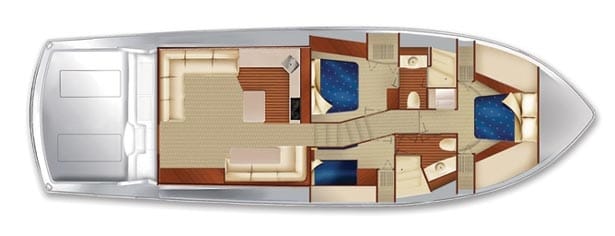
Design and Construction
Bowing to the cost-effective, ecological and technologically advanced trend, Hatteras installed LED lighting aboard the 54. Additionally, rather than installing a huge electrical distribution panel with dozens of mechanical breakers for every circuit, Hatteras switched over to KEP’s touch-screen and digital controls. A nice feature includes a solenoid that analyzes your power source, either from shore or from your own generator, and prevents you from switching to a bad power hookup in either direction.
But perhaps the most significant change/improvement in this and the other GT models is what you can’t actually see: Hatteras now employs a resin-infusion building method throughout the entire construction process. If a part is made from fiberglass, it’s been resin infused, which makes for a stronger, lighter and “greener” part.
Overall, this boat performed in truly adverse conditions with remarkable grace. Inside, it feels bigger than its size, and running, it still feels small and responsive. Hatteras pulled off quite a trick, eh?
Specifications
LOA: 57’2″
BEAM: 17’3″
DEADRISE: 16 degrees
DRAFT: 4’2″
WEIGHT: 75,000 pounds
FUEL: 1,200 gallons
MAX POWER: Twin 1,600 hp Cat C-32 diesels
MSRP: On Request
Hatteras Yachts / New Bern, North Carolina / www.hatterasyachts.com
